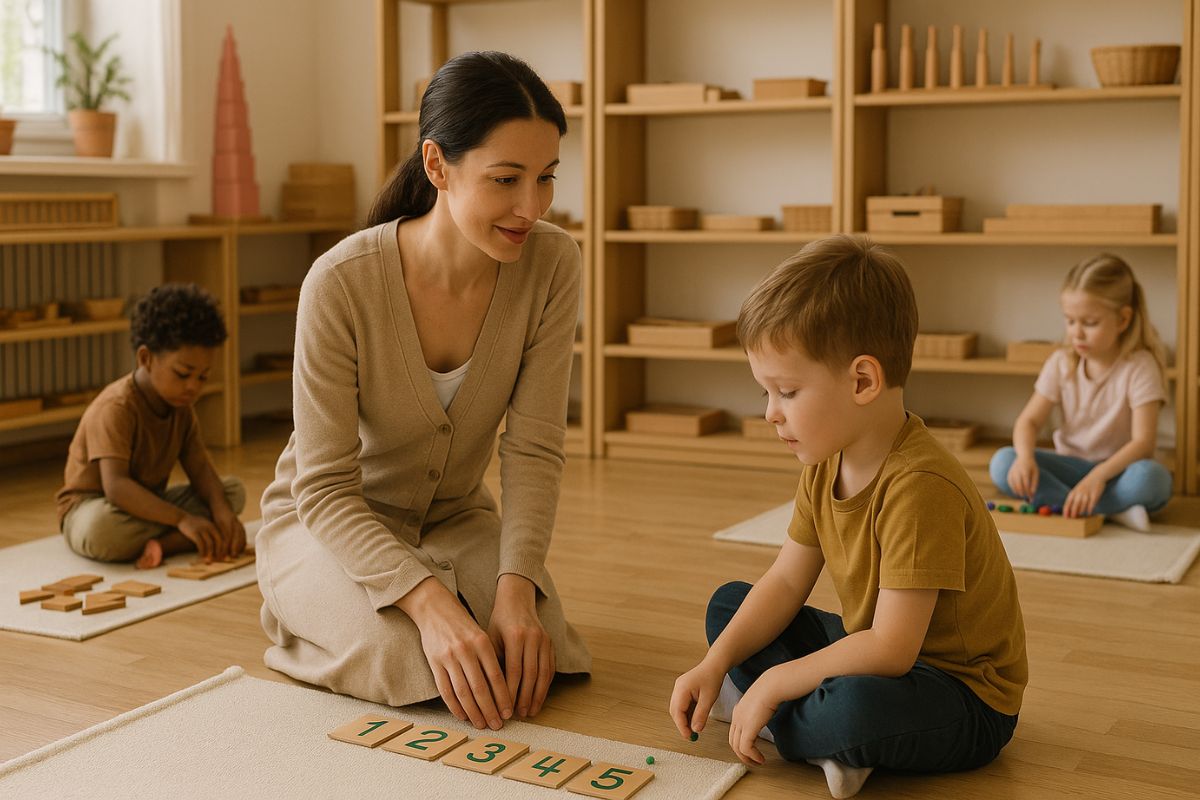In a Montessori classroom, the teacher doesn’t stand in front of the room giving lectures. Instead, they move quietly through the space, observing, offering help when needed, and guiding children toward purposeful work. Their role is gentle but deeply intentional.
Montessori teachers are trained to watch closely, listen carefully, and support each child’s development without taking over. They trust that children are capable of learning on their own when given the right environment. Their goal is to guide—not control—and to step in only when it serves the child’s progress.
What This Article Covers
This post explores how Montessori teachers support children through careful observation, meaningful lessons, and thoughtful interactions. It highlights the skills teachers use to guide rather than direct and the subtle ways they prepare the classroom to encourage independence.
You’ll get a closer look at how Montessori teachers balance freedom with structure, how they support social and emotional growth, and how their quiet presence creates a rich learning experience.
Teaching Through Observation
Observation is at the core of a Montessori teacher’s role. Rather than jumping in to correct or explain, they take time to watch. They notice how a child interacts with materials, whether they’re engaged, and where they might need support.
This allows the teacher to make decisions based on real needs. If a child repeats the same mistake, the teacher may offer a quiet lesson later. If a child seems ready for something new, the teacher can introduce a more challenging material. This kind of support is personal, thoughtful, and grounded in trust.
Observation also helps the teacher understand each child’s rhythm. Some work quickly, others slowly. Some need quiet, others need movement. By knowing each child well, the teacher can guide them without pressure or comparison.
Giving Lessons at the Right Time
Montessori teachers don’t interrupt children to give lessons. Instead, they wait for the right moment—when the child is focused, calm, and open to learning. Lessons are short, clear, and done with real materials.
After the lesson, the child is free to repeat the activity on their own. This freedom to practice without constant correction allows learning to sink in more deeply. It also builds confidence and ownership.
The goal of each lesson is not just to teach a skill, but to invite curiosity. The teacher doesn’t expect perfection. They simply show, step back, and let the child explore.
Creating a Prepared Environment
Montessori classrooms are designed to support independence. Materials are arranged neatly and accessibly. Each shelf has a purpose, and every item has a place. This setup allows children to choose their work, take care of the materials, and move around the room with confidence.
The teacher prepares this space carefully. They make sure everything is clean, complete, and ready to use. They adjust the environment as children grow, adding new materials or changing layouts to match developing needs.
By keeping the environment in order, the teacher creates calm. Children know what to expect. They can focus without distraction. And they begin to take responsibility for the space themselves.
Supporting Without Interrupting
Montessori teachers understand that learning happens best when children are deeply engaged. That’s why they avoid interrupting unless truly necessary. Instead of offering constant praise or correction, they give space for children to think and solve problems.
If a child needs help, the teacher steps in quietly and respectfully. They might offer a suggestion, model a movement, or simply watch as the child works through the challenge.
This approach shows trust. It tells the child, “I believe you can do this.” And that belief becomes part of how the child sees themselves.
Guiding Behavior with Respect
Discipline in a Montessori classroom comes from within the child, not from outside punishment. Teachers help children learn to manage their own actions by offering clear expectations, gentle reminders, and choices.
When a conflict arises, the teacher doesn’t lecture or punish. They guide the children in finding peaceful solutions. They model calm speech and respectful interaction. Over time, children learn to regulate their behavior and treat others with kindness.
This kind of guidance supports emotional growth. Children feel safe, understood, and valued. They learn that mistakes are part of learning—and that they can make better choices next time.
Following the Child’s Interests
Montessori teachers don’t use one-size-fits-all lessons. Instead, they follow each child’s interests and readiness. If a child is drawn to letters, the teacher might offer a language activity. If a child is fascinated by numbers, they might be introduced to counting materials.
This approach keeps learning joyful. Children are not forced into lessons before they’re ready. They’re invited into learning experiences that match their curiosity. The teacher acts as a guide, opening doors rather than pushing them through.
By following the child, the teacher supports natural development. Learning becomes something the child wants—not something they have to do.
Building a Culture of Respect
Montessori teachers help create a classroom culture based on respect. They speak to children with kindness. They listen carefully. They model patience, responsibility, and care for others.
This culture influences how children treat one another. They learn to wait their turn, clean up after themselves, and speak kindly. These habits grow naturally from the way the teacher guides the class—not from a list of rules or rewards.
Respect is not just taught—it’s lived. And the teacher’s example is the most powerful lesson of all.
Encouraging Lifelong Learning
The role of the Montessori teacher is not just to teach—it’s to inspire. By guiding children in a thoughtful, respectful way, they help create learners who are curious, confident, and self-motivated.
Montessori teachers understand that true learning comes from within. They support that process without rushing it. They trust each child’s pace and offer the right help at the right time.
In doing so, they plant seeds that grow into a love of learning that lasts far beyond the classroom.
